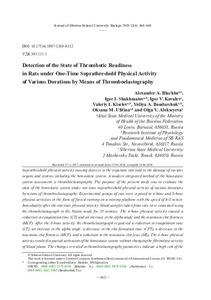Выявление состояния тромботической готовности у крыс при однократной сверхпороговой физической нагрузке разной продолжительности методом тромбоэластографии
Скачать файл:
URI (для ссылок/цитирований):
https://elib.sfu-kras.ru/handle/2311/128441Автор:
Блажко, А.А.
Шахматов, И.И.
Ковалев, И.В.
Киселев, В.И.
Бондарчук, Ю.А.
Улитина, О.М.
Алексеева, О.В.
Blazhko, Alexander A.
Shakhmatov, Igor I.
Kovalev, Igor V.
Kiselev, Valeriy I.
Bondarchuk, Yuliya A.
Ulitina, Oksana M.
Alekseyeva, Olga V.
Дата:
2019-12Журнал:
Журнал Сибирского федерального университета. Биология. Journal of Siberian Federal University. Biology 2019 12(4)Аннотация:
Сверхпороговая физическая нагрузка, вызывая в организме состояние дистресса,
может приводить к повреждению различных органов и систем, включая систему
гемостаза. Актуальным интегральным методом оценки системы гемостаза является
тромбоэластография. Целью исследования было оценить состояние системы гемостаза
крыс при однократной сверхпороговой физической нагрузке разной продолжительности с
использованием метода тромбоэластографии. Экспериментальные группы крыс подвергали
четырехчасовой и восьмичасовой физической нагрузке в виде навязанного бега в тредбане со
скоростью вращения 6–8 м/мин. Сразу после однократного воздействия физической нагрузкой
кровь исследовали на тромбоэластографе в режиме Natem в течение 35 мин. Четырехчасовая
физическая нагрузка вызывала укорочение времени коагуляции (СТ), увеличение «угла альфа»,
а также повышение максимальной твердости сгустка (MCF). По истечении восьмичасовой
физической нагрузки на тромбоэластограмме регистрировали укорочение времени коагуляции
(CT), повышение показателя «угол альфа», отмечали сокращение времени формирования Suprathreshold physical activity causing distress in the organism can lead to the damage of various
organs and systems including the hemostatic system. A modern integrated method of the hemostatic
system assessment is thromboelastography. The purpose of the present study was to evaluate the
state of the hemostatic system under one-time suprathreshold physical activity of various durations
by means of thromboelastography. Experimental groups of rats were exposed to 4-hour and 8-hour
physical activities in the form of forced running on a moving platform with the speed of 6-8 m/min.
Immediately after the one-time physical activity, blood samples taken from rats were examined using
the thrombelastograph in the Natem mode for 35 minutes. The 4-hour physical activity caused a
reduction in coagulation time (CT) and an increase in the alpha angle and the maximum clot firmness
(MCF). After the 8-hour activity, the thrombelastograph registered a reduction in coagulation time
(CT), an increase in the alpha angle, a decrease in the clot formation time (CFT), a decrease in the
maximum clot firmness (MCF), and a reduction in the maximum clot lysis (ML). The 4-hour physical
activity resulted in partial activation of the hemostatic system without changing the fibrinolytic activity
of blood plasm. The changes revealed in thromboelastography parameters indicate a high risk of the development of thrombotic readiness. The 8-hour physical activity causes a shift of the hemostatic
system parameters in rats towards the increased clot formation: hypercoagulation, fibrinogen and
platelet consumption, inhibition of fibrinolysis. The combination of changes in thromboelastogram
parameters is indicative of the development of thrombotic readiness

